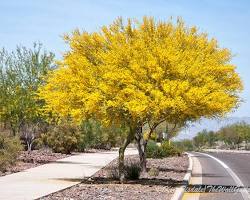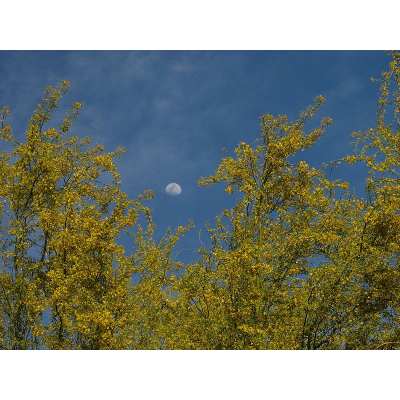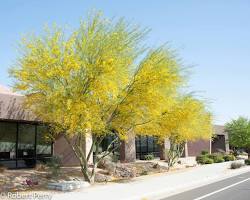In the coronary heart of the Sonoran Desert, in which the sun reigns ideally suited and water is a valuable commodity, stands a resilient image of adaptability – the palo verde tree. With its colourful inexperienced bark, delicate yellow blossoms, and deep-rooted tenacity, the palo verde has earned its place as Arizona’s country tree. However, like several dwelling organism, the palo verde comes with its personal set of pros and cons, a sensitive stability between splendor and disadvantages that have to be cautiously taken into consideration before welcoming this desert dweller into your landscape.
| Aspect | Pros | Cons |
|---|---|---|
| Drought Tolerance | – Thrives in arid environments | – Messy seed pods require regular cleanup |
| Low Maintenance | – Demands minimal care | – Presence of thorns can pose a safety concern |
| Aesthetic Appeal | – Vibrant green bark and yellow blossoms | – Potential pollen allergies for some individuals |
| Wildlife Habitat | – Provides shelter and sustenance for wildlife | – Susceptibility to certain pests and diseases |
| – Supports biodiversity in the desert ecosystem |
PRO: Drought Tolerance
Palo Verde trees are truly a triumph of nature when it comes to their remarkable drought tolerance. This remarkable trait makes them a perfect choice for arid environments where water is often scarce. Let’s delve deeper into the incredible abilities that enable Palo Verde trees to thrive even in the harshest of conditions.
The secret behind the Palo Verde’s ability to withstand prolonged periods of drought lies in its adaptation to the arid environment it calls home. One of the most remarkable features of Palo Verde trees is their deep root systems. These roots plunge deep into the earth, searching for hidden sources of moisture. This enables the tree to tap into groundwater reserves and moisture hidden deep beneath the surface, providing a reliable source of hydration even when surface water is scarce.
Another fascinating adaptation of the Palo Verde is its photosynthetic bark. Unlike most trees that rely on their leaves for photosynthesis, Palo Verde trees can produce energy even when their leaves are absent. This is a remarkable example of nature’s resilience. During dry spells, when other trees might wither and lose their leaves, Palo Verde trees continue to generate energy through their green bark. This unique feature allows them to conserve water and maintain their vitality, even in the face of adversity.
In essence, Palo Verde trees have evolved to become masters of water conservation. Their ability to access hidden moisture reserves and continue photosynthesis through their bark makes them a beacon of hope in water-scarce regions. For desert dwellers, homeowners, and landscapers in dry climates, the Palo Verde’s drought tolerance is a highly sought-after trait that can significantly reduce the need for irrigation and help conserve precious water resources.

PRO: Low Maintenance
For those with busy lifestyles or limited gardening experience, the Palo Verde tree is a true delight. Its low-maintenance nature makes it an attractive option that demands minimal attention, allowing you to enjoy the beauty of your landscape without the burden of constant care.
One of the key factors contributing to the low maintenance requirements of Palo Verde trees is their ability to thrive in adverse conditions. Their adaptability to arid environments means they require infrequent watering compared to many other tree species. This can lead to significant water savings and reduced maintenance efforts, especially in regions where water conservation is a priority.
Furthermore, Palo Verde trees are not demanding when it comes to fertilization and pruning. Unlike some other tree species that require regular feeding and shaping, Palo Verde trees can flourish with minimal intervention. This makes them an excellent choice for homeowners who prefer a hands-off approach to landscaping or those who have limited time to dedicate to their outdoor spaces.
Another advantage of Palo Verde trees is their natural resistance to pests and diseases. This reduces the need for chemical interventions and pesticides, promoting a healthier and more environmentally friendly landscape. Homeowners can take comfort in the fact that their Palo Verde trees are not only low-maintenance but also eco-friendly.
In summary, the low maintenance requirements of Palo Verde trees make them a gardener’s dream. Their ability to thrive in adverse conditions, resistance to pests and diseases, and minimal demands for watering, fertilization, and pruning make them an excellent choice for anyone looking to create a beautiful and hassle-free landscape.

PRO: Aesthetic Appeal
One cannot deny the visual charm of Palo Verde trees. These trees serve as living testaments to the beauty of the desert landscape and offer a unique aesthetic appeal that can transform any outdoor space into a desert oasis. Let’s explore the captivating elements of their appearance that make them so attractive.
The most striking feature of Palo Verde trees is their vibrant green bark. This green hue is reminiscent of the desert’s plant life and stands in stark contrast to the arid, sandy surroundings. It’s a testament to nature’s ability to create beauty in the harshest of environments. The green bark not only catches the eye but also symbolizes life and vitality in the midst of the desert’s challenges.
During the spring, Palo Verde trees burst into bloom, adorning their branches with delicate yellow blossoms. These blossoms are like golden jewels scattered amidst the dry and dusty terrain. Their bright and cheerful color adds a touch of vibrancy to the otherwise subdued desert palette. This burst of color is not only visually pleasing but also attracts pollinators, contributing to the ecosystem’s health.
The combination of green bark and yellow blossoms creates a stunning visual contrast that makes Palo Verde trees stand out in any landscape. Whether used as a focal point in a garden or as part of a larger outdoor design, these trees have the power to elevate the aesthetic appeal of their surroundings. They bring a sense of freshness and life to desert landscapes, making them a popular choice among homeowners and landscapers alike.
In conclusion, the aesthetic appeal of Palo Verde trees is undeniable. Their vibrant green bark, contrasted with the delicate yellow blossoms, transforms outdoor spaces into desert oases. These trees have the ability to infuse life, color, and beauty into arid environments, making them a highly sought-after addition to gardens and landscapes.
PRO: Wildlife Habitat
Beyond their visual charm, Palo Verde trees play a crucial role in supporting desert ecosystems by serving as vital habitats for a diverse array of wildlife. Let’s explore how these trees become havens for desert dwellers and contribute to the overall health of the ecosystem.
The shade and shelter provided by Palo Verde trees offer a safe refuge for a variety of wildlife species. Birds, in particular, find solace in the branches of these trees. The dense canopy and network of branches create an ideal environment for nesting, roosting, and foraging. Desert birds such as quails, doves, and various songbirds often make their homes in the protective embrace of Palo Verde trees.
But it’s not just birds that benefit from Palo Verde habitats. Pollinators, such as bees and butterflies, are drawn to the nectar-rich blossoms that adorn the tree’s branches during the spring. These pollinators play a critical role in the reproduction of not only the Palo Verde itself but also other plants in the surrounding area. Their presence contributes to the overall biodiversity of the desert ecosystem.
Additionally, small mammals, including squirrels and rodents, are known to seek shelter and sustenance in the branches and near the base of Palo Verde trees. The shade provided by the trees helps these creatures stay cool during the scorching desert days, while the tree’s seeds and fallen blossoms serve as a source of food.
The interconnected web of life in the desert relies on the presence of trees like the Palo Verde. By offering refuge and sustenance to a wide range of desert wildlife, these trees contribute to the delicate balance of the ecosystem. They are more than just ornamental additions to a landscape; they are essential components of a thriving desert habitat.
In summary, Palo Verde trees serve as vital habitats for a diverse array of wildlife in desert environments. They provide shade, shelter, and sustenance to birds, pollinators, and small mammals, contributing to the overall health and biodiversity of the ecosystem. Choosing to plant Palo Verde trees not only enhances the beauty of your landscape but also supports the well-being of the desert’s inhabitants.
CON: Messy Seed Pods
While Palo Verde trees offer numerous benefits, they do come with some drawbacks, and one of the most prominent among them is the issue of messy seed pods. While these seed pods play a crucial role in the tree’s reproduction, they can present a considerable cleaning challenge for homeowners. Let’s explore this downside in more detail.
As Palo Verde trees mature and produce seeds, their seed pods eventually fall to the ground. While this is a natural part of the tree’s life cycle, it can create a mess in your outdoor space. The accumulation of fallen seed pods can be unsightly, and if left unattended, it can lead to an unkempt appearance in your garden or yard.
Regular cleanup becomes necessary to maintain the aesthetics of your landscape when you have Palo Verde trees. Depending on the size and number of trees, this task can become quite labor-intensive, requiring frequent raking or sweeping to keep the area tidy. For homeowners with limited time or physical limitations, this can be a significant inconvenience.
In addition to the visual aspect, fallen seed pods can also attract pests and rodents. The seeds within the pods provide a potential food source for animals like squirrels and rats. This can lead to unwanted wildlife activity in your yard, potentially causing damage to other plants or structures and creating a further maintenance burden.
To mitigate the mess created by Palo Verde seed pods, homeowners must be prepared for regular cleaning and maintenance. This may involve investing in tools like leaf blowers or vacuums to make the task more manageable. While the trees’ other benefits are appealing, the issue of messy seed pods is an important consideration for those contemplating planting Palo Verde trees in their landscape.
CON: Thorns
Another drawback associated with some Palo Verde tree species is the presence of thorns, which can pose a safety concern, especially for children and pets. Let’s delve into the details of this downside and understand why it’s essential to consider thorns when selecting Palo Verde varieties for specific locations.
Not all Palo Verde trees have thorns, but certain species and varieties are known to produce them. These thorns can range in size and sharpness, but even relatively small thorns can cause painful injuries if stepped on or brushed against. This poses a potential hazard, especially in areas where people or pets regularly walk or play.
Children, in particular, may be more vulnerable to thorn-related injuries as they may not always be aware of the potential dangers lurking on the ground. Similarly, pets that roam freely in the yard can inadvertently encounter thorns, leading to discomfort or injury.
When selecting Palo Verde trees for your landscape, it’s crucial to consider the presence of thorns and their potential impact on safety. If you have a family with young children or pets, you may want to opt for thornless varieties or position the trees in areas where their thorns won’t pose a risk. Proper placement and consideration of safety concerns can help you enjoy the benefits of Palo Verde trees without worrying about thorn-related accidents.

CON: Allergies
While Palo Verde trees have many positive qualities, their pollen can be a source of discomfort for individuals with allergies. It’s essential to be aware of this potential downside, especially if you or your family members are prone to allergies or respiratory issues.
Palo Verde trees produce pollen, which is a natural part of their reproductive process. Unlike some other trees whose pollen is carried by the wind over long distances, Palo Verde pollen is typically heavy and does not travel far. However, it can still affect those with sensitive airways who are in close proximity to the trees.
Individuals with allergies, particularly pollen allergies, may experience symptoms such as sneezing, runny nose, itchy eyes, and respiratory discomfort when Palo Verde trees are in bloom. While these symptoms are usually temporary and tied to the tree’s flowering period, they can be bothersome for allergy sufferers.
To minimize the potential for allergies, individuals with sensitivities may need to take precautions when Palo Verde trees are in bloom. This may include staying indoors during peak flowering times or using allergy medications as recommended by a healthcare professional. While Palo Verde trees offer numerous benefits, it’s important to be mindful of their potential to trigger allergic reactions in some individuals.
 =
=
CON: Susceptibility to Certain Pests and Diseases
While Palo Verde trees are known for their overall resilience, they are not immune to certain pests and diseases. It’s essential to be aware of these potential issues and take proactive measures to prevent and manage them to ensure the health of your trees. Let’s explore some of the common pests and diseases that can affect Palo Verde trees.
One notable pest that can pose a threat to Palo Verde trees is the Palo Verde beetle. These large beetles can cause damage to the tree’s bark and leaves. While they are not always present and may not be a significant problem in all regions, their presence can lead to cosmetic damage and potentially weaken the tree.
To prevent Palo Verde beetle infestations, regular monitoring of your trees is essential. Early detection allows for prompt action, such as the removal of affected branches or the use of appropriate insecticides if necessary.
Another concern is the susceptibility of Palo Verde trees to certain fungal diseases. These diseases can affect various parts of the tree, including the leaves and branches. Symptoms may include discoloration, wilting, and dieback of affected areas.
To minimize the risk of fungal diseases, it’s crucial to provide proper care for your Palo Verde trees. This includes ensuring good air circulation, avoiding overwatering, and maintaining healthy soil conditions. Proper pruning and the removal of dead or diseased branches can also help prevent the spread of fungal infections.
In conclusion, while Palo Verde trees are generally hardy and resilient, they are not immune to potential issues such as Palo Verde beetles and fungal diseases. Homeowners who choose to plant Palo Verde trees should be vigilant in monitoring their health and taking proactive measures to prevent and address these issues. With proper care and attention, Palo Verde trees can continue to thrive and provide their numerous benefits to the landscape.
Read Next : Fun Facts About Palo Verde Trees
Related Post : Japanese Pagoda Tree Pros and Cons
